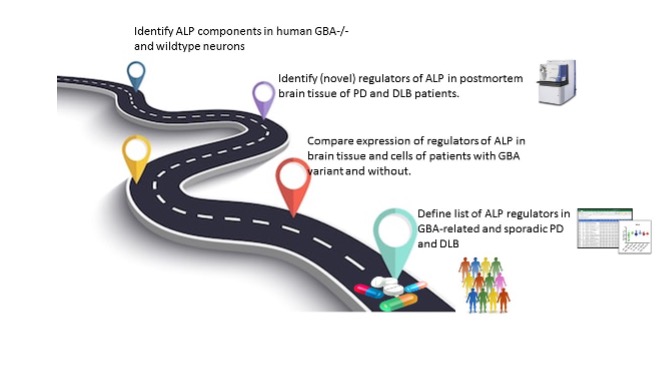Abnormal protein degradation in familial and sporadic Parkinson’s disease
Current pharmacologic treatment of Parkinson’s disease is merely symptomatic, mainly pharmacotherapy that aims to alleviate motor disturbances through dopamine replacement. Development of disease-modifying therapies that delay or stop disease progression, is an important unmet need. To discover potential novel drug targets for parkinson’s disease, we will closely collaborate with Roche Pharma and study regulation of protein degradation mechanisms in cells and brains of Parkinson’s patients.
Parkinson’s disease is the second most common neurodegenerative disorder, with an annual incidence of 8,000 and an estimated prevalence of 50,000 patients in the Netherlands. The socioeconomic burden of PD is high, up to €1.0 billion per year and is expected to increase further. Improving the treatment of patients suffering from Parkinson’s, in particular when influencing inpatient care and nursing home admission, and personalized care, would strongly contribute to a reduction of the burden for patients, caregivers and society.
The key concept of the project is that by exploring the molecular landscape of autophagy-lysosomal mechanisms in parkinson’s and dementia with Lewy body disease patient biomaterial, we will gain mechanistic insights into the chemical forces that drive these diseases. Restoring autophagy-lysosomal components may be interesting for the development of disease-modifying treatment paradigms for familial and sporadic Parkinson’s disease and dementia with Lewy bodies. This study will also offer new biomarker candidates for improved detection, monitoring and insight in (master) regulators of brain pathology as a prelude to disease-modifying therapeutic intervention for these devastating diseases.
We will provide a list of proteins that play a key role in regulation of autophagy-lysosomal pathway and alpha-synuclein aggregation in brains of Parkinson’s disease and dementia with Lewy body patients. In follow-up studies, these data may be utilized to develop novel disease-modifying therapeutic strategies and diagnostic tools for molecular subtypes in Parkinson’s disease.
In the ALP-disease project, we have identified components of the autophagy-lysosomal pathways, among which glucocerebrosidase (GCase), mTORC1, LIMPII and LAMTOR1 and SORL1, which were deregulated in Parkinson and Dementia with Lewy body patient biosamples with and without GBA mutations. We showed that a reduction of GCase can be rescued in neurons (in vitro) with by chronic cerezyme treatment, currently used as enzyme replacement therapy for Gaucher disease. We showed that SORL1 expression is strongly related to levels the reduction in GCase levels in PD/DLB brain. This suggests a direct link between these proteins. As SORL1 is a member of the retromer family, it suggests that cellular trafficking is impaired. We showed that TFEB, the master regulator of the autophagy-lysosomal pathway is accumulation in the cytoplasm not able to traffic to the nucleus in neurons. This leads to less autophagy-lysosomal gene expression. We confirmed this by mRNA analysis and showed that the expression of several genes in the autophagy-lysosomal pathway is decreased. Overall our results suggests that several components of the autophagy-lysosomal pathway are deregulated in incidental PD (early stage disease), more advanced sPD/DLB, and most severely in GBA-PD/DLB and that SORL1 is an interesting novel therapeutic target to consider for followup studies.




